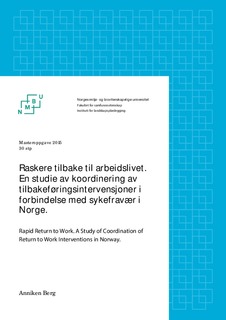| dc.contributor.author | Berg, Anniken | |
| dc.date.accessioned | 2015-11-05T10:11:39Z | |
| dc.date.available | 2015-11-05T10:11:39Z | |
| dc.date.copyright | 2015 | |
| dc.date.issued | 2015-11-05 | |
| dc.identifier.uri | http://hdl.handle.net/11250/2359393 | |
| dc.description.abstract | Bakgrunn: Studier viser at mangel på koordinering, samhandling og samarbeid mellom sykmeldt, arbeidsgiver og andre aktører i helse- og velferdstjenester kan komplisere og forlenge tilbakeføringen til arbeid hos sykmeldte. En tilbakeførings- koordinator kan ha en positiv effekt på dette. Raskere tilbake-ordningens type tilbud er finansiert av Regionale Helseforetak (RHF) og/eller NAV. Det er få retningslinjer når det kommer til hva tilbudene skal inkludere, og ordningen har blitt kritisert for å ikke ta arbeidsplassdimensjonen i sykefraværsarbeidet innover seg, samt at de mangler et definert rammeverk for hvordan de samhandler, samarbeider og koordinerer. Målsetningen med denne studien er å undersøke hvilke faktorer som predikerer koordinering, samhandling og fast koordinator i Raskere tilbake-ordningen i Norge. Design: Tverrsnittstudie som er intervjubasert av faglig og/eller administrativ ansvarlig av 120 Raskere tilbake-tilbud som en del av den nasjonale evalueringen av Raskere tilbake-ordningen. Resultat: De oftest rapporterte verktøyene for koordinering var tverrfaglig team, og å utvikle planer for hver Raskere tilbake-mottaker. En fast koordinator blir oppnevnt i nesten halvparten av tilfellene i hele utvalget. Videre rapporteres det ulikt innen de ulike tilbudene når det kommer til samarbeid med arbeidsplass. Det er signifikante assosiasjoner mellom å ha et Raskere tilbake-tilbud finansiert av NAV og en fast koordinator (OR=2,2, 95% CI=1,06-4,63), samt i tilbud som har begge finansieringer (NAV og RHF) (OR= 4,3, 95% CI= 1,45-12,57). Videre var assosiasjon mellom muskel- og skjelettplager og fast koordinator signifikant (OR = 3.8, 95% CI=1.37 to 10.40). Konklusjon: Funnene i denne studien viser at det er forskjell i å oppnevne fast koordinator mellom de ulike finansieringstypene i Raskere tilbake-ordningen, samt en forskjell hva gjelder fast koordinator når det kommer til diagnosegrupper. Gjennom de deskriptive data kan det tyde på at det er forskjeller mellom de ulike tilbudene når det kommer til koordinering og samhandling i forhold til veldokumenterte koordineringsverktøy innen tilbakeføringsarbeidet. | nb_NO |
| dc.description.abstract | Background: Earlier studies have found that lack of cooperation and coordination between the worker, employer and other stakeholders from health- and social insurance can complicate and prolong return to work (RTW). A Return To Work coordinator can on the other hand have a positive effect on RTW. The Rapid Return to Work program in Norway, financed by the Regional Health Authorities (RHA) and/or the Norwegian Labour and Welfare administration (NAV) are providing the programs. There are few guidelines for what the programs should include and they have been criticized for not having paid enough attention to the workplace aspect and lacks a defined framework for cooperation and coordination. The aim of this study is to investigate what factors predicts coordination, cooperation and providing a permanent coordinator in the Rapid Return To Work program. The aim of this study is to investigate what factors predicts coordination cooperation and providing a permanent coordinator in the Rapid Return To Work program. Design: Interview based cross-sectional study with professional and/or administrative responsible person in Rapid Return To Work programs (n=120). Descriptive analyses were conducted to investigate coordination and cooperation. Differences in provision of permanent coordinator in the type of finance and among the diagnose groups were investigated with bivariate tables/cross tabulation. Result: The most frequent reported instrument of coordination is a multidisciplinary team and making a plan for each Rapid RTW receiver. Cooperation with the workplace differs in type of finance and type of programs. There was a significant association between having a program financed by the Norwegian Labour and Welfare administration (NAV), and a permanent coordinator (OR=2,2, 95% CI=1,06- 4,63). Having a program financed by both RHA and NAV, and a permanent coordinator was significant (OR= 4,3, 95% CI= 1,45-12,57). The association between musculoskeletal conditions and having a permanent coordinator was significant (OR = 3.8, 95% CI=1.37 to 10.40). Conclusion: Findings in this study indicate differences in providing a permanent coordinator between types of finance and in between diagnose groups in the Rapid RTW program. The reporting from the Rapid RTW programs indicates there are differences in the type of programs and type of finance in cooperation and coordination when it comes to well-documented RTW coordination instruments. | nb_NO |
| dc.language.iso | nob | nb_NO |
| dc.publisher | Norwegian University of Life Sciences, Ås | |
| dc.subject | Sykefravær | nb_NO |
| dc.subject | Koordinering | nb_NO |
| dc.subject | Raskere tilbake | nb_NO |
| dc.subject | Tilbakeføringsintervensjon | nb_NO |
| dc.subject | Samhandling | nb_NO |
| dc.subject | Return to work | nb_NO |
| dc.title | Raskere tilbake til arbeidslivet : en studie av koordinering av tilbakeføringsintervensjoner i forbindelse med sykefravær i Norge | nb_NO |
| dc.title.alternative | Rapid Return to Work. A study of coordination of Return to Work interventions in Norway | nb_NO |
| dc.type | Master thesis | nb_NO |
| dc.subject.nsi | VDP::Social science: 200 | nb_NO |
| dc.source.pagenumber | 86 | nb_NO |
| dc.description.localcode | M-FOL | nb_NO |
